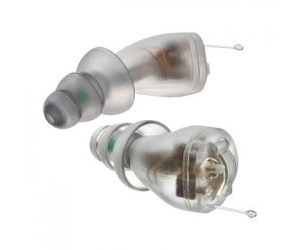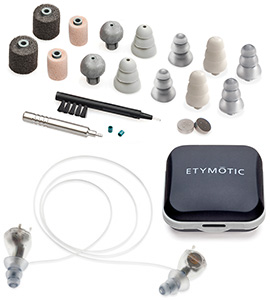Review: Etymotic MUSIC PRO 9-15 High Fidelity Electronic Musicians Earplugs
Earplugs equals ear protection, and every musician knows they are essential.
The problem when it comes to hearing protection has been this: How do you block sound when it exceeds harmful levels, but at the same time retain the ability to listen clearly and comfortably without taking out the earplugs?
Etymotic continues to stay “true to the ear” with its new Music•PRO 9-15 earplugs for the price of $399 a pair. The MP•9-15 was designed for all who want to hear naturally but also need protection from sudden-impact noise and/or loud sound that is sustained for an extended amount of time.
As sound levels increase, the earplugs provide the option of 9- or 15 dB sound reduction with the flick of a switch. Adaptive attenuation lets the user hear naturally as if nothing was in the ears, until sound exceeds safe levels. In this way, the MP•9-15 earplugs offers an unprecedented capability in that it acts both as an electronic earplug and a personal hearing device.
TWO MODES
Via a switch on the MP•9-15 earplugs, users can select between one of two modes:
9 dB mode (enhancement mode) — this mode provides 6 dB enhancement of soft sounds and 9-dB protection when sound exceeds safe levels.
15 dB mode (natural hearing mode) — natural hearing when it is quiet and 15 dB protection when sound exceeds safe levels.
HIGH FIDELITY– HIGH DEFINITION
MP•9-15 earplugs contain high definition transducers: balanced-armature drivers, high-sensitivity microphones, and wide-dynamic range-compression circuitry. They are designed with what Etymotic refers to as K-AMP signal processing, which includes adaptive compression circuitry. The bandwidth is 40 Hz – 16 kHz.
The MP•9-15 earplugs run electronically so batteries are required, and each device uses one #312 zinc air battery. Easy to replace, it is key to unhitch (open battery door) when not in use.
Since they come complete with a range of seven eartips, custom ear molding is not required but is supported. The MP•9-15 earplugs are clear and are connected with a clear cord which is very helpful, because I am always afraid of losing one out of two and have run into this problem in the past. Included for transportation is a hardtop protective case.
TESTING GROUND
I was fortunate enough to test the MP•9-15 at three different music venue locations in and around New York City.
First, I gave them a whirl at the Bowery Ballroom for an concert indie rock show featuring the Bright Light Social Hour, Black Taxi and Echosuite. The atmosphere was loud rock and roll, so I chose 15dB protection.
The result: These earplugs made a big difference in the way I heard the music. I compared them in and out of both ears and alternatively switched between modes while testing. I felt that the earplugs were snug in my ear canal for accurate protection, and I was able to still hear the highs of vocals, guitars and keyboards clearly, while also not losing the low-frequency power of the bass guitar and drums. Most importantly, I was able to hear the concert and converse with noticeable ease, without muffling or distortion.
My second attempt was an outdoor beach club environment, for the Nervous Party with DJ Oscar G at Neptunes Beach Club in Hampton Bays. Made in Miami, DJ Oscar G is famous for his addiction to drums and is a slave to the dark beat. I chose the 15dB protection for the low-end frequency. I’m happy to report that I was still able to hear the soulful vocals and feeling of the sultry tribal drums. After eight hours of straight listening, I was not ear-fatigued despite being very close to the pulsating speakers.
Thirdly, for my last experience I saw K.D Lang and the Siss Boom Bang in concert at the Westhampton Beach Performing Arts Center. The opening act was an acoustic performance by southern folk singer Lera Lynn. I switched the MP•9-15 earplugs over into 9-dB mode, because I did not need as much protection. I was able to hear every word and be soulfully serenaded by K.D Lang and her soothing vocals.
In conclusion, the MP•9-15 earplugs can be used in a variety of musical environments. Any loud musical venue such as a concert, club, performance or even during a loud rehearsal or practice. Ideal for the person who needs protection such as DJs, directors, music educators, engineers, performing musicians (especially symphony and jazz) , front-of-house crews, entertainment industry support staff, security personnel and audiences.
FEEDBACK
In the past I have always lusted for quality custom ear plugs, but felt discouraged from seeing an ear specialist and getting an ear molding due to the associated expense. Although Music Pro •9-15 earplugs are a significant investment relative to most non-custom earplugs, they still offer good value for the money.
Improvements I’d suggest would start with appearances — the earplugs are not visually pleasing. They sort of stick out of the ear and look a bit alien-esque, but this is because there are a lot of little mechanics compacted into one tiny multipurpose earplug, so they stand out. Beyond aesthetics, protecting your hearing is what’s important and what’s cool (spread the word!).
The Music Pro•9-15 high definition ear plugs provide an extremely high level of hearing protection while still allowing you to preserve, listen and enjoy your favorite music.
— Jacqueline Smiley
Please note: When you buy products through links on this page, we may earn an affiliate commission.









TR
September 11, 2012 at 2:12 pm (13 years ago)15dB is not a lot of protection. If you were at a loud rehearsal, sound level could exceed 120 dB for hours on end. So, you’d be at 105dB for hours on end. Not too great.
DB
September 11, 2012 at 3:52 pm (13 years ago)An attenuation of 9 dB (or 15 dB) does not sound like a lot, but let’s
do some math. Every 3 dB of attenuation (which is barely detectable) is
“one half the damage.” Another 3 dB of attenuation (now we’re down to 6
dB) is another one half, so it’s a quarter of the damage. And another 3
dB of attenuation means that we are down to 1/8 of the damage. So, 9
dB attenuation means that a person can be exposed 8 times as long as
without hearing protection. If you were disposed to continue on to a
calculation for an attenuation of 15 dB then that person can be exposed
32 times as long as without hearing protection. Attenuations of 9 dB
and 15 dB don’t sound like a lot, but they definitely are.
J.Smiley
September 11, 2012 at 5:49 pm (13 years ago)helpful chart
J.S
September 11, 2012 at 5:53 pm (13 years ago)check this out
J.S
September 11, 2012 at 6:08 pm (13 years ago)check out the performance graph at the bottom of the page
http://www.etymotic.com/hp/mp915.html